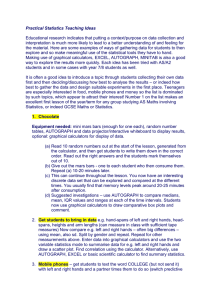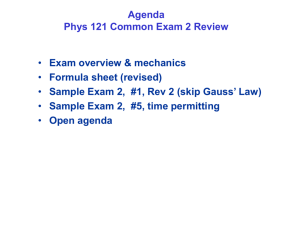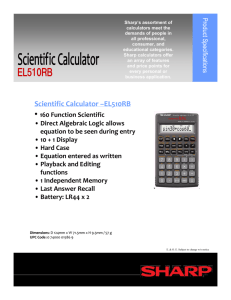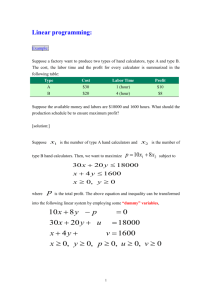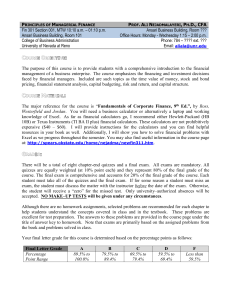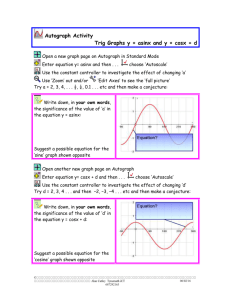Teaching Key Statistical My experience in Statistics Education
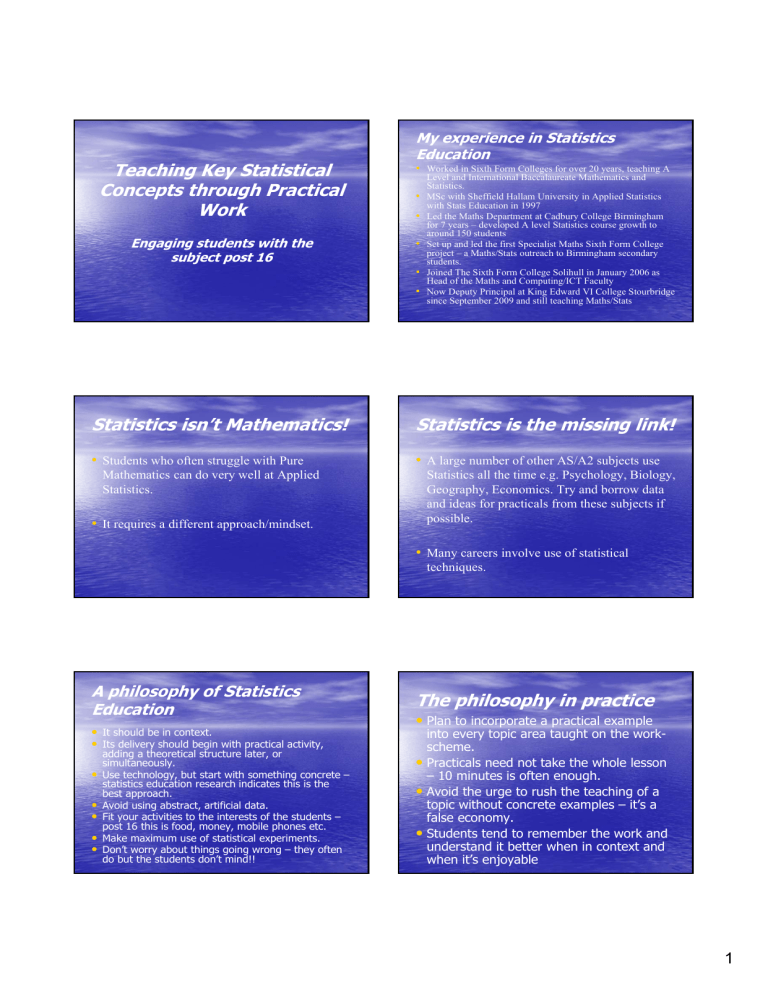
Teaching Key Statistical
Concepts through Practical
Work
Engaging students with the subject post 16
My experience in Statistics
Education
• Worked in Sixth Form Colleges for over 20 years, teaching A
Level and International Baccalaureate Mathematics and
Statistics.
• MSc with Sheffield Hallam University in Applied Statistics with Stats Education in 1997
• Led the Maths Department at Cadbury College Birmingham for 7 years – developed A level Statistics course growth to around 150 students
• Set up and led the first Specialist Maths Sixth Form College project – a Maths/Stats outreach to Birmingham secondary students.
• Joined The Sixth Form College Solihull in January 2006 as
Head of the Maths and Computing/ICT Faculty
• Now Deputy Principal at King Edward VI College Stourbridge since September 2009 and still teaching Maths/Stats
Statistics isn’t Mathematics!
• Students who often struggle with Pure
Mathematics can do very well at Applied
Statistics.
• It requires a different approach/mindset.
Statistics is the missing link!
• A large number of other AS/A2 subjects use
Statistics all the time e.g. Psychology, Biology,
Geography, Economics. Try and borrow data and ideas for practicals from these subjects if possible.
• Many careers involve use of statistical techniques.
A philosophy of Statistics
Education
• It should be in context.
• Its delivery should begin with practical activity, adding a theoretical structure later, or simultaneously.
• Use technology, but start with something concrete – statistics education research indicates this is the best approach.
• Avoid using abstract, artificial data.
• Fit your activities to the interests of the students – post 16 this is food, money, mobile phones etc.
• Make maximum use of statistical experiments.
• Don’t worry about things going wrong – they often do but the students don’t mind!!
The philosophy in practice
• Plan to incorporate a practical example into every topic area taught on the workscheme.
• Practicals need not take the whole lesson
– 10 minutes is often enough.
• Avoid the urge to rush the teaching of a topic without concrete examples – it’s a false economy.
• Students tend to remember the work and understand it better when in context and when it’s enjoyable
1
Descriptive Statistics: the importance of the first lesson
• (a) Do something memorable
– e.g. a smokers’ fitness experiment:
50
40
30
100
Boxplot of Increase in pulse rate with exercise vs Smoker
90
80
70
60
No Yes
Smoker
(b) Mars Bars and Memory – a good first lesson at AS level
• Record how many random digits out of 10 students can remember at lesson start.
• Students consume a mini mars bar and the memory test is repeated every 5-10 minutes.
• Results recorded and represented on box plots
– can use graphics calculators, AUTOGRAPH,
MINITAB
• Memory peaks around 20 minutes after consumption.
Results of Mars Experiment
8
7
10
9
6
5
4
3
2
1
Boxplot of Memory Scores over time after mars bar consumption
0 5 10 15 20 25
(c) A practical example – works with year 7 upwards
Poverty
• Distribute squares of CDM bar around class – do it unevenly.
• Obtain class reaction – unfair?
• Calculate mean – arrange it to be 2 if possible.
• Discussion on averages to ensue – which is best one.
• Give say 6 squares of chocolate to the boy/girl with most – mean increases! Link to Aid to developing countries and question of corruption.
• Students decide how to redistribute squares so median is 2 and then mode is 2.
(d) A Trip to the Grave!
• Find the nearest large church graveyard and divide the land into areas e.g. older graves, recent, child/family burials (if distinct areas in yard).
• Assign groups of students to each area.
• Students start at a random point and use dice and coins to decide movement (left, right, forward or back then number of paces)
• Record details on nearest grave – age at death, gender, occupation (if there), size of headstone, date buried etc.
• Pool data on return and use as a basis of class and project work.
Probability: (a) Race Track
• Make a simple circular race track board game out of card with two lanes.
• Students play in fours, advancing according to dice, overtaking if throw a six when behind an opponent
• One pair drives on each side of the road and arrange an obstacle so that students can’t see what’s coming round a bend
• Students play a round repeatedly
• Record accident data and find conditional probability of a collision on a bend.
• Can use computer game/simulations if available.
2
(b)Dicey Statistics!
• Give each child a die and explain that you are interested in finding out the most likely number of throws up to and including the first six – ask them to guess this first.
• Carry out the experiment once and tally results.
Repeat for greater sample size.
• Students are usually surprised by the result.
• Many people’s instincts about probability are based on false ideas.
Dice Experiment Theory
• A Geometric Distribution
• Let X = the number of throws up to and including the first six
X ~ G (1/6)
P(X = 1) = 1/6
P(X = 2) = 1/6 * 5/6
P(X = 3) = 1/6 * (5/6)* (5/6) etc.
• Mean 1/(1/6) = 6
X = 1 or 2 are the most likely scores
X
15
16
17
18
10
11
12
13
14
7
8
5
6
9
1
2
3
4
Probability
0.166666667
0.138888889
0.115740741
0.096450617
0.080375514
0.066979595
0.055816329
0.046513608
0.03876134
0.032301117
0.026917597
0.022431331
0.018692776
0.015577313
0.012981094
0.010817579
0.009014649
0.007512207
Predicted number in sample of 60
10
8
7
6
1
1
2
2
1
3
3
5
4
2
1
0
1
1
Hypothesis Testing: examples of
Practicals in teenage context
(a) Mobile Phones
• Start with a question – are students ambidextrous?
• What does that mean and how can we test it – student responses.
• Make use of simple equipment – could use rulers, calculators, but best is a mobile phone – all students possess one!
• Students time each other in pairs to text (not send) the word
‘college’ with left and right hands separately.
• Analysis depends on level – could use comparative box plots, hypothesis test on differences (t test or Wilcoxon Test). Can also look at spread of data and breakdown into gender etc.
(b) Chocolate
Does Chocolate increase ability to concentrate?
• A variation on the Mars Bars experiment.
• Compare before and after (15 minutes approx.) consumption scores in remembering 10 random numbers.
• Use AUTOGRAPH and Binomial Distribution
– a sign test.
(c) Choc Chip Cookies
• Get students to rate on a scale of 1-10 the test of say Sainsbury’s own choc chip cookies versus
Maryland cookies
• Label as brand A and B and randomize which cookie is eaten first using the toss of a coin
• students to drink some water between cookies and possibly blindfold them as well – done in pairs).
• Compare brand A and B to see if they can tell the difference - first work out the differences between ratings for each person to get a single set of data.
3
Cookies continued
• if there is no difference you’d expect the average of these differences to be close to zero
– test using Sign, Wilcoxon test or paired t test.
• Students usually can’t tell the difference – discuss why spend more on Maryland!
• Extension – students decide which aspects of cookies to compare (e.g. Taste, weight, diameter, number of chips per cookie) and then carry out a practical and analysis of their choosing, presenting to class using posters
(d) Smarties
• Group students and give a tube of smarties to each group.
• Ask them to list how they might measure/decide on quality of smarties – discuss as a class.
• Each group gathers data on one aspect of their choosing and conducts suitable hypothesis test e.g. test whether there are more than 3 deformed smarties in a tube.
• Could also look at number of reds, weight, total number in tube, taste of two colours
Probability Distributions:
Scandal
(a) Modelling a Poisson Distribution
• Distribute newspapers around the room– all have same brand of paper (Daily Mail, Guardian etc.)
• Ask to record the number of scandals in the first five pages.
• Data is messy – what is a scandal?
• Could also count number of pictures, number of
‘feelgood/happy’ stories.
• Find mean and variance on calculators from class data – usually very close to each other. Fit a Poisson model – usually very good fit (don’t worry if it isn’t)
Binomial Distribution
Concentration and Music
• Give students a set of simple multi choice questions to complete in a set time and then mark. Record results and find mean and variance – use to estimate p and check fit to a
Binomial.
• Repeat using a similar question set but whilst playing soft music. Then again using a rock music track.
• Compare values of p across three experiments – usually peaks in soft music
What about the dry topics such as Normal Distribution?
• Make them as practical as possible – see next slide
• Limit exposition at board
• Use e.g. card-matching activities to get students practicing without realising
• Avoid endless repetition of textbook exercises – use selectively. Try some marking exercises instead.
• Mini whiteboards useful in testing understanding.
• Variety essential.
Quality Street & Quality Control
• Students find mean and sd for each sweet type’s weight in a box of QS. Use small groups
• Use whole class data to find estimate of µ and σ .
• Now use linear combinations of normal variables to find mean and variance for net weight of whole box
• Compare mean calculated with printed net weight.
• Find probability, using parameter estimates, of weight in a box being less than printed – in an individual box and also in a batch of say 20 boxes.
4
General Points........
Use of Technology
Technology is a vital tool in doing statistics. It’s use in the classroom can be extremely helpful:
• AUTOGRAPH – useful for recording, graphing, analysing data collected.
• MINITAB – a more powerful tool. Diagrams and analytical tools superior to AUTOGRAPH and EXCEL.
• EXCEL – spreadsheets can be useful in a variety of ways e.g. in simulations.
• Graphics calculators – many statistical functions and graphing tools.
Something all can get their hands on.
• Internet – use of websites to provide data sets, applets etc.
• Use of VLEs such as Moodle to provide interactive content
Avoid over-use of technology.
Try and use a concrete, practical example of something with students first.
Statistics in the Real World
• Try and plan at least one trip a year which illustrates work covered in classroom e.g. visit to Cadbury’s factory to see quality control in action.
• Get a statistician to come in and talk about their work.
• Even better, stage a Statistics Conference at school/college – one at Cadbury College over recent years (Mobile Phones, Heart Disease).
• Make it cross – curricular (involve Biologists, social scientists) and work together with other institutions
(other schools, the RSS, a local university etc.)
Don’t be afraid to experiment!
The course will be a success if you :
• Build in practical activities into work-schemes in
EACH topic and encourage staff to try new ideas.
• Observe each other teaching – be supportive.
Team-teaching can also help.
• Continue to produce a bank of low and hi-tech activities (card-matching, dominoes, data-sets on MINITAB and AUTOGRAPH etc.) and incorporate into your work-schemes.
This will take time (a two –year project) – involve the whole department, use Standards
Unit materials and templates to help.
Planning the course
• Plan variety into individual lessons and the organisation of each term.
• Have at least one field trip/visit per year
• Embed practical application/context into each topic – how is it used in the real world?
• Allow for the use of different student learning styles.
• Have regular reviews after each topic and build in at least 4 weeks of revision before each set of exams if possible.
• Show enthusiasm for the subject!
In Closing …..
• Statistics is a fascinating subject pre and post
16.
• Students really enjoy using it to deal with realworld problems.
• C grade students up to A* students can do VERY well on an A/AS Level Statistics course (AQA or
MEI).
• There is a desperate need world-wide for statisticians, and excellent career prospects for those who study it in higher education.
• It is a really rewarding subject to teach.
5
Practical Statistics Teaching Ideas
Educational research indicates that putting a context/purpose on data collection and interpretation is much more likely to lead to a better understanding of and feeling for the material. Here are some examples of ways of gathering data for students to then explore and so make meaningful use of the statistical tools they have to hand.
Making use of graphical calculators, EXCEL, AUTOGRAPH, MINITAB is also a good way to explore the results more quickly. Each idea has been tried with AS/A2 students and in some cases with year 7/8 students as well.
It is often a good idea to introduce a topic through students collecting their own data first and then deciding/discussing how best to analyse the results – or indeed how best to gather the data and design suitable experiments in the first place. Teenagers are especially interested in food, mobile phones and money so the list is dominated by such topics, which appear to attract their interest! Number 1 on the list makes an excellent first lesson of the year/term for any group studying AS Maths involving
Statistics, or indeed GCSE Maths or Statistics.
1. Chocolate
Equipment needed: mini mars bars (enough for one each), random number tables, AUTOGRAPH and data projector/interactive whiteboard to display results, optional: graphical calculators for display of data.
(a) Read 10 random numbers out at the start of the lesson, generated from the calculator, and then get students to write them down in the correct order. Read out the right answers and the students mark themselves out of 10.
(b) Give out the mars bars - one to each student who then consume them.
Repeat (a) 10-20 minutes later.
(c) This can continue throughout the lesson. You now have an interesting discrete data set that can be explored and compared at the different times. You usually find that memory levels peak around 20-25 minutes after consumption.
(d) Suggested investigations – use AUTOGRAPH to compare medians, mean, IQR values and ranges at each of the time intervals. Students now use graphical calculators to draw comparative box plots and comment.
2. Get students to bring in data e.g. hand-spans of left and right hands, headspans, heights and arm lengths (can measure in class with sufficient tape measures) Now compare e.g. left and right hands – often big differences – using mean, also sd. Split by gender and repeat. Repeat for other measurements above. Enter data into graphical calculators and use the two variable statistics mode to summarise data for e.g. left and right hands and draw a scatter plot. Find correlation using the calculator. Alternatively, use
AUTOGRAPH, EXCEL or basic scientific calculator to find summary statistics.
3. Mobile phones – get students to text the word COLLEGE (but not send it) with left and right hands and a partner times them to do so (switch predictive
texting off first!). Record data for class and compare main and non-main hands – is there a difference or are they ambidextrous? The analysis that can be done with the graphical calculators, on AUTOGRAPH or by hand depends on the student context, e.g.:
(i) If A2 students could carry out a hypothesis test on the differences (paired t test)
(ii) If AS students, they could use the calculators/ATOGRAPH to draw scatter plot for left and right hands and find a correlation. You could also get the students to use the one variable statistics mode to find the summary measures for the differences between each hand and comment.
Interestingly, data may suggest that this generation is becoming more ambidextrous, perhaps due to things like texting and computer gaming skills.
4. Rulers – drop a ruler through your main hand and record the distance dropped. Repeat and take result on third drop. Now repeat with other hand and then compare results for the whole class using mean, s.d., median etc., again using the calculators to provide rapid results.
5. Newspapers/magazines – there is a theory that the more expensive colour adverts for goods have a greater proportion of the colour black in them. Use a grid to approximate the proportion of a series of magazine adverts which is coloured black and record the price of the item. The data can be analysed graphically on calculators/EXCEL/AUTOGRAPH or by hand and correlation can be brought in as well. You can categorise the adverts by the kind of goods being sold – clothing, electrical, food etc etc. and use mean, sd to compare prices and proportions of black in different categories. You can also construct a price – black proportion ratio to create a univariate data set and then compare using mean, sd across the categories of advert.
6. Taste Tests – get students to rate on a scale of 1-10 the test of say
Sainsbury’s own choc chip cookies versus Maryland cookies (labelling them as brand A and B and randomizing which cookie is eaten first using the toss of a coin – students to drink some water between cookies and possibly blindfold them as well – done in pairs). You can then compare brand A and B to see if they can tell the difference, having first worked out the differences between ratings for each person to get a single set of data, which is then inputted into calculators or examined by hand and using an ordinary scientific calculator. Clearly if there is no difference you would expect the average of these differences to be close to zero, but there will be a degree of variation as measured by the sd of the data which is worth also discussing. All of this can be extended to e.g. non-parametric testing such as the sign test or Wilcoxon test using calculators to support the analysis.
7. Cadbury’s Dairy Milk – distribute squares of chocolate (could use maltesars or any chocolate/fruit/sweets which are easy to distribute) around the room, but ensure that it is very uneven, with several getting none, some e.g. 8 squares, some 4, some 2, some 1 etc. The idea is to demonstrate the
difference between mean, mode and median, with a discussion as to which measure is best in this context. Can also lead in to discussion of things like aid to developing countries and mismatch between ‘haves’ and ‘have-nots’.
Students can then be asked to redistribute the squares in order to achieve a particular median, mode etc. Graphical calcs can be used to find quartiles and other measures if desired. This lesson goes down well with students (even tried it with a group of year 7 and 8 students – bottom sets in an 11-16 school
– and got good responses). Can clearly be used for numeracy and GCSE students as well.
8. Pulse Rates – get students to do some simple piece of exercise e.g. running round the field, press-ups etc, taking pulse before and then immediately afterwards. Time to return to previous pulse can also be measured. For each student doing the exercise the increase in pulse rate can be measured from resting rate to post-exercise. The data can then be explored using mean, median, IQR etc. on the calculators. An extension is to group separately by smokers and non-smokers and compare – the sporty students who also smoke often get a shock. Some students I have done this with in the past, using Autograph to display the data, have subsequently given up smoking as a result of what the data showed!
Instructions for using Autograph with an example of the data collected are given below:
(i) Open a new statistics page. Click on DATA-ENTER GROUPED DATA
Class intervals - equal intervals, integer data or manual
Frequencies - either manual or calculated from raw data
Edit raw data – dialogue box-manual entry import or cut/paste from a spreadsheet create sample from a probability
distribution.
(ii) Click on OBJECT and select diagram type.
Clicking on the name of the data set in the bottom left allows you to further edit the data.
9. Jammy Dodgers – bring in a few packets and measure the diameters of a sample. Use combination of linear variables to find mean and s.d. for a row of four (the width of a packet). Now get students to find the mean of a row of four biscuits plus or minus 3 sds using class data – gives a range typically one centimetre wide for 99.9% of data. You should find that there is always a half a centimetre slack in the packaging at either end to allow for variability in size of the biscuits, giving a practical use for linear combinations.
10. Quality Street – a variation on (9) above. Bring in boxes of quality street and get the students in groups of 3 or 4 to find the mean and sd for each sweet type in the box. Now pool data for the whole class – you’ll almost certainly find that the mean and sd are the same for each box. Using whole class data, find the mean and sd for each sweet type and using these as approximations for
population mean and sd find mean and sd for net weight of whole box. Now use standard normal distribution techniques to find the probability that the net weight is below that printed on the box. This allows for discussion of the use of statistical techniques in quality control.
11. Cookies Comparison – students compare own brand (e.g. Sainsbury’s own) and Maryland using variables of their choice – different for each small group of 3 or 4 students. The small groups then analyse the results depending on their level of knowledge and feed back at the end of the lesson using posters they create. This works well in a long lesson (say 80-90 minutes) and can be appropriate for e.g. Further Stats modules for F Maths students or Stats 1 students – just suggest a different level of analysis. Either way, the analysis can be done quickly in a single lesson, allowing the students to think carefully about what they are doing. There is ample opportunity to use effective differentiation within such a lesson.
12. A Visit to the graveyard – find a large local graveyard and divide the yard into sections, preferably by grave type (e.g. children, cremations, older graves etc). Assign a group of students to each section and ask them to sample a selection of graves – you could do so in proportion to the number in each section or just get them to sample the same from each section if the sections are similar in size. The process of choosing a sample needs to be discussed first, but could involve a coin toss for moving left or right, back or forward and then a die to indicate the number of paces moved forward or back. Students should record for each grave the information available on: gender, age, date of birth and death, profession (where available), number of words on tomb etc. The data is messy – some stones will be hard to read or difficult to get to
– but then this is real statistics which rarely involves sanitised data. Clearly risk assessments first are important – take care of hidden holes etc!
Analysis is then possible as a project, exploring the data using descriptive statistics, graphs such as box-plots, pie charts etc. The initial lesson can be conducted in an 80-90 period and provides plenty of real data to use in developing understanding of uni and bivariate statistics.
The key in all of this is to get the students realizing that statistics can be useful and fun in analysing/exploring real-world situations. Try not to give all the answers as well, so for instance in taste tests leave problems with the experimental design or ask them to design the experiment, allowing discussion between and with the students.
Try to build a statistics practical or two into work-schemes for each topic covered. My experience is that students remember the topics covered using this practical approach much better than using data from a textbook or website. Not only that, grades in examinations are much higher as a result. Also, as many practicals can be done quite quickly, the theory can be taught without losing time in hectic schedules.
Finally, I have also found that my enjoyment as a teacher of statistics has increased greatly since using this approach to teaching the subject and that the students are very tolerant of the occasional flop lesson – they value the opportunity to try something new.
